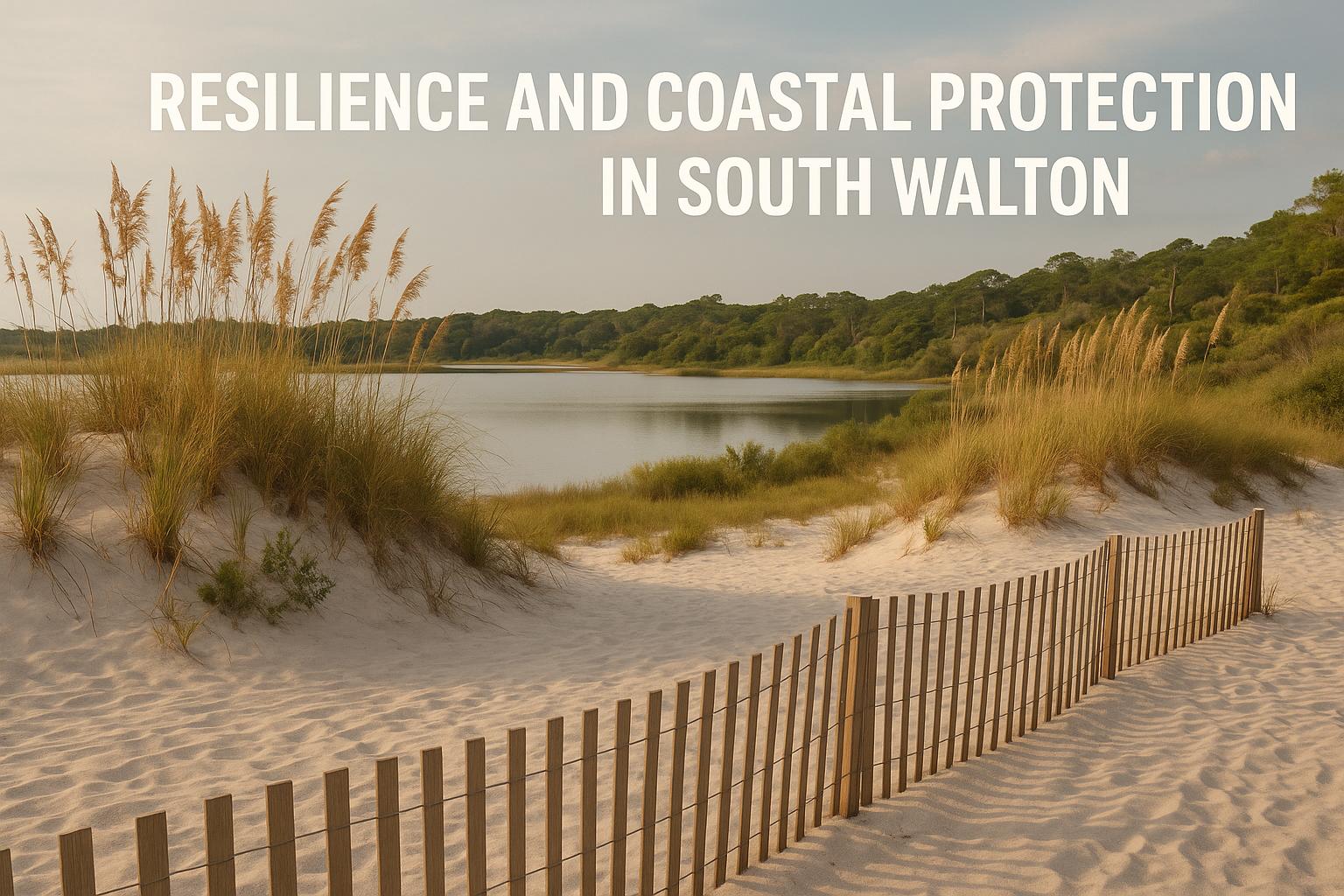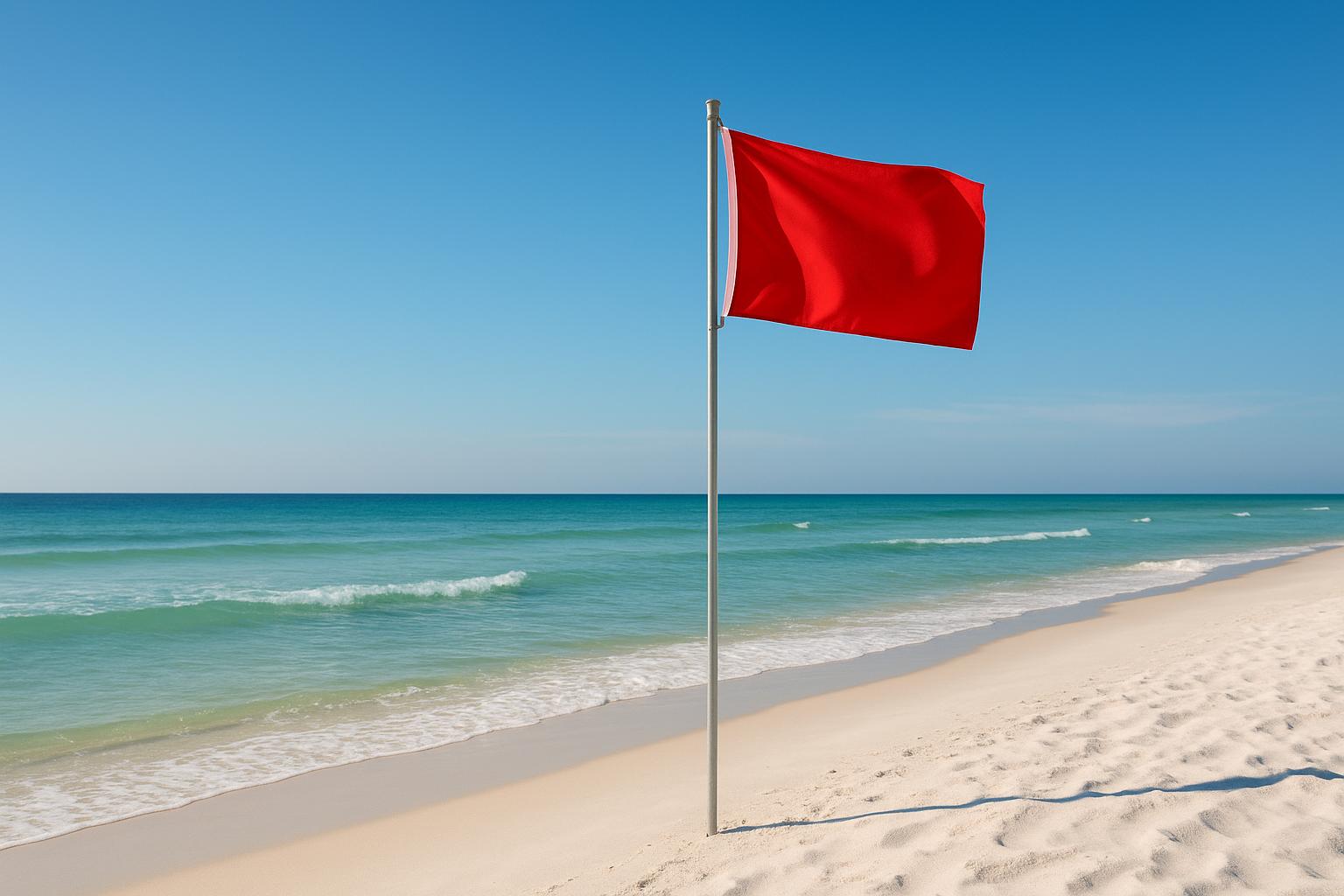Hurricane season runs from June 1 to November 30, with the most active months being August through October. If you’re visiting South Walton, preparation is key to staying safe. Here’s a quick breakdown of the five most important safety tips:
- Know Your Evacuation Zone and Route: Check your zone (A-F) to understand evacuation priorities. Visit floridadisaster.org/knowyourzone for details.
- Pack an Emergency Kit: Include water, non-perishable food, medications, important documents, and essentials for at least three days.
- Track Weather and Alerts: Sign up for AlertWalton to get real-time updates and warnings. Use trusted sources like NOAA and the National Weather Service.
- Prepare Your Accommodation: Ensure your lodging has storm protocols, emergency supplies, and reinforced structures.
- Stay Safe During and After the Storm: Avoid windows, stay in secure areas, and monitor official updates. After the storm, watch for hazards like downed power lines and flooding.
Planning ahead and staying informed can help you navigate any storm-related challenges during your visit. For more resources, check out sowal.co and Walton County Emergency Management’s official channels.
Florida Hurricane Safety Tips For Visitors
1. Learn Your Evacuation Zone and Routes
Start by identifying your evacuation zone. In South Walton, evacuation zones are labeled from A to F. Zone A, being the most at risk, is evacuated first, while Zone E is typically among the last to be cleared. These zones are based on areas prone to flooding and the potential for storm surge during hurricanes.
To find your evacuation zone, visit the "Know Your Zone Map" at floridadisaster.org/knowyourzone. Simply enter your address to determine your zone and evacuation priority.
If you’re located in Zones A or B, take evacuation seriously - these areas are most susceptible to dangerous storm surges. Mobile homes and properties in low-lying areas are especially at risk. Make sure you plan your evacuation route in advance.
For South Walton residents, U.S. 331 North serves as the primary evacuation route. This crucial corridor connects the coastal region to safer inland areas, with the Choctawhatchee Bay Bridge playing a vital role in the process. Keep in mind, limited routes mean heavy traffic is likely as many people evacuate at once.
Knowing your zone and route is a critical part of hurricane preparedness. If you’re in a high-risk area, don’t wait for mandatory evacuation orders to act. Stay informed by monitoring local news and following updates from officials as storms approach.
For up-to-date evacuation details and emergency resources tailored to South Walton, visit sowal.co. It’s a helpful hub for local emergency management information.
2. Pack an Emergency Supply Kit
Having an emergency kit ready can make all the difference between a smooth evacuation and a chaotic situation. Be sure to pack supplies that will last at least three days.
Start with water - it’s the most critical item. Plan for a three-day supply per person to cover drinking, cooking, and basic hygiene needs.
Next, focus on food. Choose non-perishable items like canned goods, energy bars, dried fruits, nuts, and crackers - basically, anything your family will actually eat.
Don’t forget medications. Pack a minimum seven-day supply of essential prescription drugs, clearly labeled, along with common over-the-counter items like pain relievers, antacids, and vitamins. During hurricanes, power outages and supply chain disruptions can make it nearly impossible to get to a pharmacy.
Keep your important documents safe. Make copies of IDs, insurance policies, medical records, and emergency contact lists. Store them in waterproof containers or use encrypted digital backups. For extra protection, double-bag the copies and keep the originals securely at home.
Organize your supplies in airtight bags and place them in easy-to-carry containers, like plastic bins or duffel bags. Don’t forget essentials like phone chargers, and make sure everyone in your household knows where the kit is stored.
Having this kit ready to go means you won’t waste precious time scrambling for supplies when evacuation orders are issued. It’s a simple but crucial part of being prepared for a safer experience in South Walton.
3. Track Local Weather and Emergency Alerts
Keeping up with changing weather conditions isn't just helpful - it can be a lifesaver. In South Walton, hurricanes can bring sudden shifts in weather, making real-time updates a crucial part of your safety plan. By staying connected to location-specific alerts, you can better prepare and respond to emergencies as they arise.
Start by registering for AlertWalton, Walton County's official emergency notification system. This free service sends important updates - like severe weather alerts, evacuation orders, and other public safety warnings - straight to your phone, email, or landline.
"AlertWalton is a mass notification system that allows our staff to provide Walton County residents and visitors with timely alerts." - Walton County, FL
Signing up is quick and easy at www.alertwalton.org. You can even add your temporary accommodation address to receive alerts tailored to your specific location in South Walton. Rest assured, the system is only used for real emergencies - you won’t get spam or promotional messages.
For more detailed updates, check out the National Weather Service (weather.gov). Their site offers a wealth of resources, including tropical weather updates, radar imagery, and detailed forecasts. One particularly helpful tool is their Hurricane Threats and Impacts (HTI) Graphics, found at weather.gov/srh/tropical. These graphics provide a clear picture of potential conditions during tropical watches and warnings, helping you prepare for the worst-case scenario.
Stay connected through multiple channels. Follow Walton County Emergency Management on social media for timely updates, and consider downloading trusted emergency apps like those from FEMA or the Red Cross.
"Walton County EM is the OFFICIAL source of emergency notification, warning messages and preparedness tips for Walton County, Florida." - Walton County Emergency Management
Since weather can change rapidly during a hurricane, it’s essential to monitor official sources regularly. Set up notifications on your phone and check these outlets frequently to ensure you have the time you need to act and stay safe.
sbb-itb-d06eda6
4. Prepare Your Accommodation
Making sure your lodging is ready for a hurricane is just as important as knowing your evacuation routes. Whether you're staying at a beachfront hotel or a vacation rental, it's essential to confirm that your accommodation is prepared for severe weather. This can save you from unnecessary stress when a storm hits.
Start by checking with your property manager or booking agent about the property's hurricane protocols and evacuation routes. Having this information ahead of time ensures you're not scrambling under pressure.
Look into whether the property is equipped with storm shutters or pre-cut plywood for windows, reinforced garage doors (if applicable), and a plan for securing outdoor furniture to minimize risks from flying debris during high winds.
Ask if your accommodation provides an emergency kit. Essentials like flashlights, extra batteries, and basic first aid supplies can make a big difference in a storm.
If you're staying in Sandestin, you're in luck - there's dedicated support available during severe weather. The Sandestin Owners Association offers updates through their hotline at 1-844-SOA-NEWS (toll-free) or 1-850-424-5921 (local). For properties managed by specific companies in Sandestin, you can contact them directly for assistance. For example:
- First Service Residential: 622-6222
- Emerald Coast Association Management: 654-8660
- Newman Daily: 837-1071.
Lastly, keep your property manager’s or hotel’s contact details saved on your phone. Communication lines can get overwhelmed during a hurricane, so having quick access to this information can be a lifesaver. By ensuring clear protocols and safety measures are in place, you can feel more secure during any storm.
5. Stay Safe During and After the Storm
When a hurricane hits South Walton, making smart decisions during and after the storm is crucial for your safety. The NWS National Hurricane Center Miami FL advises, "Persons in these areas should be prepared to take shelter in the interior portion of a well-built structure and remain sheltered until after hazardous conditions pass." Here's how you can protect yourself and those around you throughout the storm's impact.
During the hurricane, stay away from windows, skylights, and glass doors. Instead, find an interior room on the lower floor of your accommodation - preferably a reinforced room, closet, or bathroom. The WaterColor Community guidelines emphasize, "If you remain in the home, avoid windows and doors." Avoid using candles or kerosene lamps for lighting to reduce fire risks. If the power goes out, turn off major appliances to prevent power surges when electricity is restored. If flooding is a concern, immediately shut off power at the main breaker. It's also a good idea to fill your bathtub with water for flushing toilets and sanitation. Store drinking water in jugs or bottles to ensure you have a clean supply.
Don’t be deceived by the calm when the eye of the hurricane passes overhead. This quiet period doesn’t mean the storm is over, and hazardous conditions can resume quickly. Stay sheltered until officials confirm it’s safe to come out.
Once the storm has passed, keep safety top of mind. Continue monitoring NOAA Weather Radio or local news for updates and official safety declarations. For the latest updates specific to Walton County, follow Walton County Emergency Management on Facebook (www.facebook.com/WaltonCountyEM), Twitter (@WaltonCountyEM), or visit WaltonCountyEM.org.
Before venturing outside, inspect the perimeter of your property carefully. Look out for loose power lines, gas leaks, or structural damage. If you smell gas, see floodwaters around the building, or haven’t received an official safety clearance, do not enter. Only drive if absolutely necessary, steering clear of flooded roads and washed-out bridges. Remember, just six inches of moving water can knock you off your feet, and 12 inches can carry away a vehicle. Be cautious of fallen objects, downed electrical wires, and unstable structures that could collapse unexpectedly. For verified road closures in the area, check https://bit.ly/34y4vuf.
Always wait for official clearance before resuming normal activities to ensure your safety.
Conclusion
Staying safe during hurricane season in South Walton requires preparation and staying informed. The five key steps - knowing your evacuation zone and routes, assembling an emergency supply kit, monitoring weather alerts, preparing your accommodations, and staying cautious during and after the storm - serve as a solid foundation to safeguard yourself and your loved ones.
Being proactive makes all the difference. Sign up for emergency alerts at AlertWalton.org and follow Walton County Emergency Management on social media for timely updates. For more details about local emergency plans and resources, visit the official Walton County Emergencies & Storms page at mywaltonfl.gov/449/Emergencies-Storms.
If you're new to the area, digital resources like sowal.co provide helpful guides and updates on South Walton's 30A coastline.
Take steps now to prepare: check flood zones for accommodations at MyFloodZoneFlorida.com, save nhc.noaa.gov for hurricane forecasts, and use FloridaDisaster.org for evacuation maps. Planning ahead ensures a safer and more secure visit.
FAQs
How can I check if my South Walton vacation rental is prepared for hurricanes?
To make sure your vacation rental is prepared for a hurricane, contact the property manager or rental agency. Check if the property has storm shutters, emergency kits, and a well-defined evacuation plan in place. Verify that it complies with local safety standards and ensure emergency contact information will be accessible throughout your stay.
What should I pack in an emergency kit for hurricane season in South Walton?
When heading to South Walton during hurricane season, being prepared with an emergency kit is a must. Pack enough water - about 1 gallon per person per day for at least three days - along with non-perishable food to last the same period. Other essentials include a battery-powered or hand-crank radio (preferably one with NOAA weather alerts), flashlights and extra batteries, and a first aid kit.
Don't overlook personal hygiene items, sanitation supplies, necessary medications, and copies of important documents. Having these on hand can save you from unnecessary stress in an emergency.
Make sure your kit is easy to access and ready to go before your trip. Keep an eye on local weather updates and follow evacuation orders without hesitation to ensure the safety of you and your loved ones.
How can I stay informed about weather alerts and evacuation updates while visiting South Walton?
To keep up with weather alerts and evacuation updates in South Walton, consider signing up for the AlertWalton system. This service sends timely notifications to both residents and visitors, helping everyone stay informed. Plus, if you have a WEA-capable phone, you'll automatically receive critical emergency alerts - no app download required.
You can also follow Walton County Emergency Management on social media for real-time updates, and check the Florida Disaster website for the latest evacuation orders and safety tips. Staying informed and ready is essential during hurricane season to help protect yourself and your loved ones.



